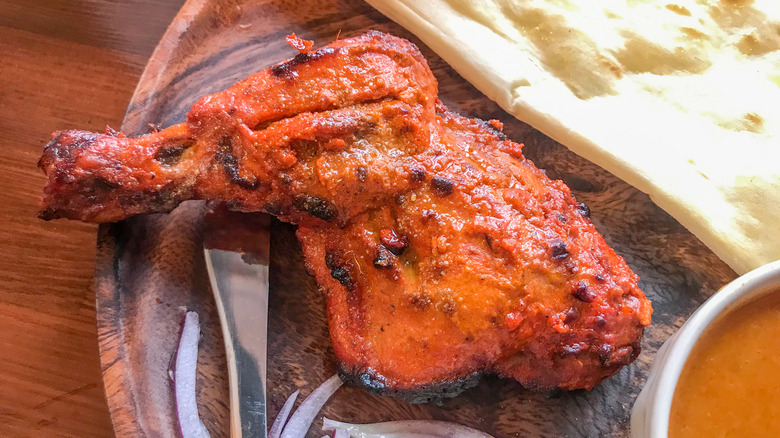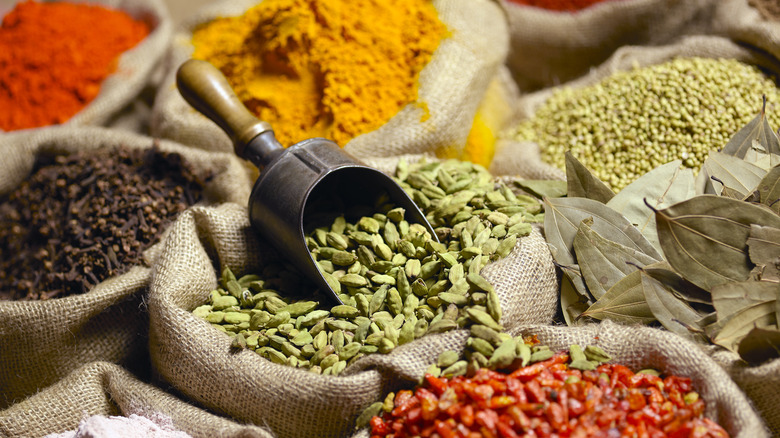Crucial Tips To Keep In Mind For Homemade Tandoori Chicken
Consisting of smoky chicken thighs marinated in a mix of yogurt and spices, tandoori chicken is a go-to meal when visiting your favorite Indian restaurant. Keep in mind that tandoori chicken is a dish you can also master at home, and you can hone your technique with guidance from culinary professionals possessing extensive experience with Indian cuisine. To that end, Daily Meal turned to two chefs to get their insights on how to make it in your home kitchen.
Chef and restaurateur Varun Inamdar, who shares cooking tips via his YouTube channel "Get Curried" and Chintan Pandya, chef and partner at NYC-based restaurants Dhamaka and Adda, were kind enough to offer their advice regarding homemade tandoori chicken. Both chefs highlighted the importance of properly marinating it to ensure the deepest flavor.
Pandya said that it's important to allow the meat to remain in the marinade overnight to ensure the flavor "seeps inside the chicken." Similarly, Inamdar urged home chefs to "marinate well" by allowing the poultry to remain in curd or yogurt overnight. Inamdar also recommended cutting into the chicken, which helps it fully absorb the marinade and ensures even doneness. When cutting the meat for tandoori recipes, it's best to cut it to the bone for full flavor integration.
How to create an unforgettable flavor
When it comes to the ingredients that go into tandoori chicken, how you incorporate your spices makes a world of difference to the end result. Varun Inamdar encouraged the use of fresh spices for a "robust flavor." Chintan Pandya also recommended using fresh spices but urged home chefs to go one step further by toasting the spices before incorporating them into the dish to derive even more flavor. Keep in mind that the point of toasting spices is to release their inherent oils, which makes for a much bolder, more potent flavor.
According to Inamdar, acidic ingredients are also essential in tandoori chicken and he advised using "lemon juice or vinegar, or both" to break down the meat and allow the marinade to flow in. In addition to creating the most pleasing flavor, Inamdar also had a tip for preventing unwanted flavors in the dish. The chef stated, "Avoid metal to prevent metallic taste" in your recipe, which entails using "non-reactive bowls" when bringing together ingredients. In this case, you'll want to use cookware made from glass, ceramic, or stainless steel, which are all considered non-reactive.
Cooking techniques and tools to create tasty tandoori chicken
The flavor is key when it comes to homemade tandoori chicken, but a sumptuous texture is equally important. Accordingly, certain cooking techniques keep the meat moist and prevent it from drying out. "Keep on basting [your] chicken with butter whilst it's cooking so it remains moist," explained Chintan Pandy. At a minimum, you should baste the thigh meat at least twice over the course of a 30-minute cooking time.
Varun Inamdar pointed out that bringing the poultry to room temperature before cooking is equally important, as room temps ensure that meat cooks evenly, which results in a moister texture. If you're wondering how long food can stay out before food safety becomes an issue, two hours is the absolute limit. It's also important to use the right kitchen tools.
Along with "a basting brush for keeping the poultry moist," Inamdar suggested that home chefs should have a handy pair of tongs to flip the chicken thighs, as well as a meat thermometer to guarantee doneness. The chef stated that you should "aim for 165 degrees Fahrenheit" when it comes to the internal temperature, which is backed up by the USDA. Lastly, he said to avoid overcrowding for even cooking by arranging the meat in one layer.


